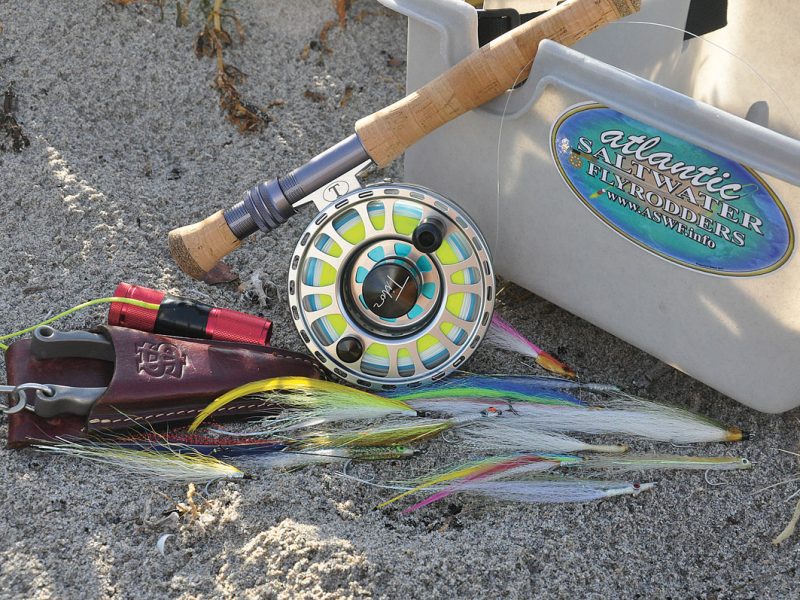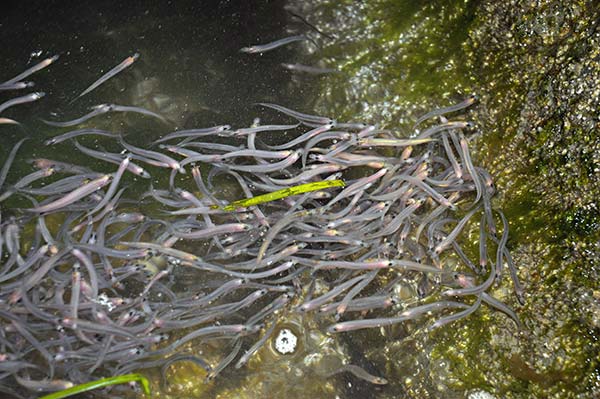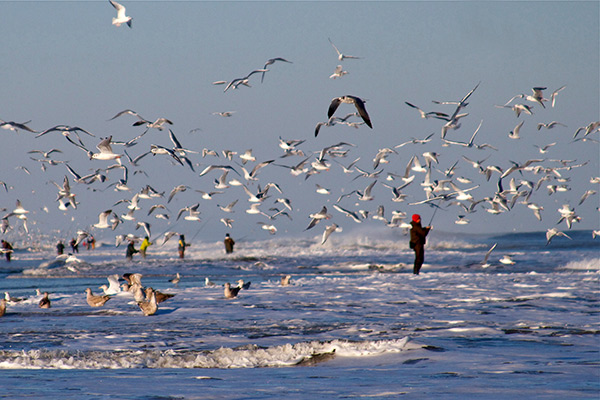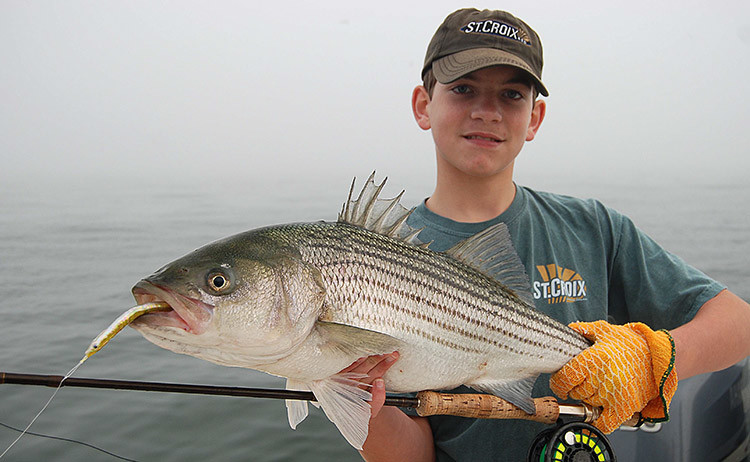Amazing Sand Eels
The sand eel is common from Nova Scotia to North Carolina and is an important food source for striped bass from spring to fall.

“Get your butt down here, and bring your fly rod!” The phone call was from John Bushell at Betty and Nick’s Bait & Tackle just up the road from Island Beach State Park. “There’s a sand eel invasion down at the jetty and this morning the bass were biting like mad dogs.” His call came in around noon on a mid-November day in 1974. It took only a few moments to grab my Fenwick FF9010 and waders, fill the Thermos with coffee, lock the office, fire up my Jeep Wagoneer and head south. An hour-and-a-half later, I was at the end of the beach road, dropping the Jeep’s tire pressure. I switched into four-wheel-drive and rumbled along through the sand to the jetty, where sand eels were bringing big bass within fly-casting range.
(Note: On The Water is reader-supported. When you buy through links on our site, we may earn an affiliate commission.)
John’s camouflage-painted Blazer, along with a dozen or so other beach buggies and surf guys, was parked 50 yards from the North Jetty. I had fished with him before, but with spinning gear, and had told him that I really wanted a bass on the fly in the surf. “I think you’ll get your wish,” John said, as we waited for the sun to get lower in the west. At 4:30 p.m., the bite started. The edge of the surf came alive with slithering sand eels trying to burrow into the sand while schoolie-size striped bass attacked from every angle, their backs often completely out of the foaming water.
The sand eels were huge, not the little fluke-bait sizes, but fat like fountain pens. The spin-fishermen were throwing small Alou Eels and Boone needlefish plugs to match the bait size. I had several Deceivers in my fly bag that were supposed to imitate mullet, but they were long enough to resemble a sand eel, and so got plenty of strikes. This was a memorable late afternoon of easy, short casts. There were plenty of tugs from eager bass, fly-line-burned fingers, and a bloody thumb from jaw-grabbing so many bass.

About Sand Eels
Sand eel populations have fluctuated over the years, and so have the bass, but November remains one of the best months to catch striped bass along the beach, especially when the sand eels show up. Locally, some coastal areas see huge numbers of sand eels in the surf while others, like Jersey’s Monmouth and Cape May counties, have seen declines. Fly-rodders in these areas head to Ocean County and Long Beach Island to get in on the sand eel action. “I think beach replenishment is responsible,” says Capt. Bill Hoblitzell of Outback Charters, “The sand eels don’t seem to come inshore that much.” Fortunately, other areas on Long Island and in New Jersey have not experienced this and flyrodders can easily find other good beaches.
The sand eel is common from Nova Scotia to North Carolina, and is an important food source for striped bass from spring, when the newly-spawned 2- to 3-inchers are predominant, through fall when the surf and inshore waters can be packed with 4- to 6-inch baits. The sand eel’s elongated, slender shape resembles an eel, and it seeks shelter and safety by burying itself in the sand; hence the name.
Sand Eel Flies
There are many excellent fly patterns that imitate a sand eel. Hoblitzell likes sparsely tied Deceivers and Clouser Minnows, and the Gartside Corsair, a classic sand eel pattern that, as Bill says, “Works great on calm nights.” Capt. Robbie Barradale of the Bayshore Saltwater Flyrodders likes, “…anything long and skinny like the Bob Popovics Surf Candy in tan and olive over white. Another favorite of mine is a bendback-style pattern tied with Steve Farrar’s Flashbend and includes a few strands of ostrich herl for the top wing.”

Paul McCain at River Bay Outfitters in Oceanside, Long Island, also likes sparsely-tied flies and leans toward the Lefty’s Deceiver or the Surf Candy, while Rick Ferrin, another Long Islander says, “I’ve had good luck with a modified Dave Skok Mushmouth. “I tie it sparse but long, and use a short-shank hook so there’s less chance of fouling the materials while casting.”
Depending on the bottom and water clarity, live sand eels can vary in color, from glaring chrome-like silver with a light olive back or with a black back and vivid shades of pink, neon blue and deep purple on the sides and a white belly. One of my personal sand eel favorites is a Rhody-style fly I tie long and skinny on an Owner AKI hook with a mix of bucktail, feathers, and flash in yellow, blue, red, and purple on the top and white for the belly. If I’m a throwing a sinking line and dragging the fly through the sand, I use the same style fly, but tie it on a freshwater bass hook, often called a Z-hook (for rigging rubber worms). This hook rides with the point up and slithers through the sand with no damage to the hook point.
When the sand eels are abundant along the beaches, there are three daily time periods when fly-casters should concentrate their efforts: dusk, night, and dawn. Sand eels move into the shallows in the late afternoon into dusk, and the striped bass follow them right into the wash. The bite can ebb and flow, with brief but ferocious bites, a slacking off, and then a hot bite again.
Starting late afternoon, Barradale likes to cast a 9- or 10-weight with an intermediate line, casting up-current about 45 degrees to the beach. “I use short, jerky strips in a very erratic action that make the fly appear like a disoriented or panicked sand eel trying to escape. A steady, even retrieve doesn’t work so well. If I have to get down below the surface, I use weighted flies, and if I want to probe the bottom, I’ll switch to a 300- to 500-grain sink tip to overcome the influence of the wave motion and currents.”

After dark, there’s usually a brief lull, but then a steady appearance of sand eels will show all through the night. While some remain burrowed in the sand, others will come to the surface to feed on plankton that also rises to the surface in the darkness. If the surf is calm, the bass can be heard “popping” as they feed on sand eels near the surface. Bill Hoblitzell takes advantage of these calm nights and fishes a floating line to keep the fly just below the surface, where bass will oblige with eager takes. The night bite is also prime time when bigger bass may be more likely to be caught.
The dawn bite sees sand eels leaving their safe haven as they quickly school up and head for the daytime sanctuary of deeper water. The bites can be rapid, like the staccato firing of a machine gun, as the striped bass feed with amazing aggressiveness. Unlike the more leisurely pace of the dusk and night bites, the dawn action can end with the snap of the fingers. One moment you’re into a blast of bass, the next you’re cloaked in eerie silence.
Paul McCain tries to be on the beach before dawn on a high outgoing tide, and if the fish gods are really smiling, there’ll be small surf with a light wind. “Most times, the bass are within a few feet of the shore. I’m using a two-handed rod and a line with a fast-sink tip. I prefer sparse lightweight flies, so when I drag the fly line on the bottom, the fly is suspended a few inches up and off the bottom.”

Cloudy weather can make the dawn bite last longer, and I recall one morning several years ago at the Manasquan Inlet’s north pocket when drizzling rain and thick, dark clouds obliterated the sunrise. The striped bass bite, fed by an enormous number of sand eels, lasted until nearly 9 a.m.
There may still be some mullet around in November and perhaps some peanut bunker too, but many fly guys will be keeping their eyes on the beach, waiting for the sand eels to trigger the grand finale to this year’s fly-rod striped bass action. If we’re lucky, it may stretch the season well into December.
Related Content
Article: The Loop Fly— A Pattern for Albies and Stripers
5 on “Amazing Sand Eels”
-
Charles Thank you for the excellent informative article!
-
Michael Byers I always love reading Pete’s treatises on Salt Water Flyfishing. Of course Pete always covers alot of local angling history and the legends of whom created it. Whether it is John Bushell, Russ Wilson and others, Pete’s always seems to bring a smile on my face at the same time as giving an informative lesson. I’m not sure Pete Barrett realizes what a local legend and tutor, through his affiliation with many publications over the years, he is …. particularly to the Jersey Shore. I attended Barrett headlined fishing seminars long before that off season institution became vogue. OTW is fortunate to have Pete in it’s stable. Please keep it coming and Thank You !
-
James starkey I’m new to surfcasting and love all the information and excitement given to us through these stories and shared events of fishing
-
Ronald Thank you for your contribution to my knowledges 🙂
-
Patrick Hender I have been fishing manasquan since the mid 1980s.i have nights when I had to swim back to shore from the sandbar cause the night was so hot.you would get hit with you’re lure floating in front of me wile I lit a joint or a smoke.many smokes and joints got wet and ruined from the splash but worth it.my old friend Glen and I loved to Wade to the sandbars in November nights during low tide when the sandeels were around.the would sometimes use our bodies for cover .I would look down and the water was black and I felt them bouncing of my waiders.since beach replenishment goes on every year now sandbars don’t build up and or last but if you find one head out use a needlefish with a redgill teaser have fun.but don’t stay to long or you will be swimming threw the trough back in .worth it.
Leave a Reply